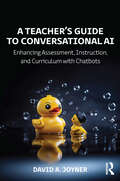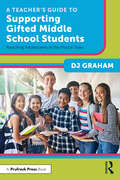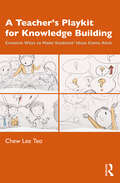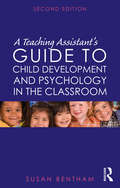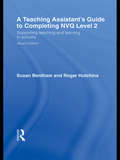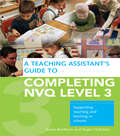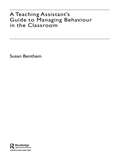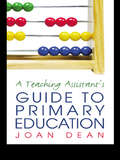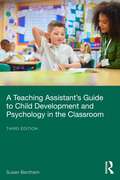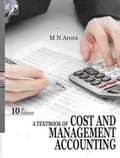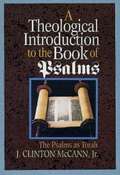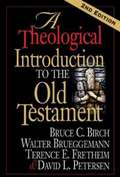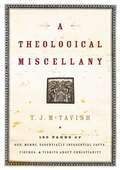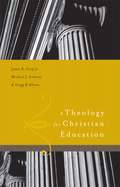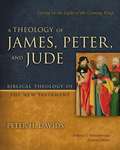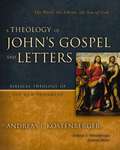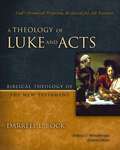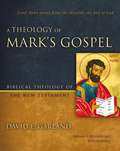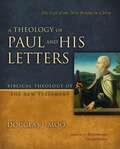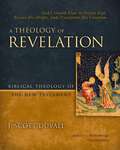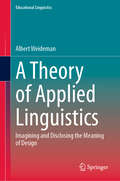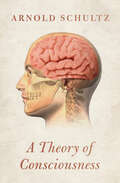- Table View
- List View
A Teacher’s Guide to Conversational AI: Enhancing Assessment, Instruction, and Curriculum with Chatbots
by David A. JoynerA Teacher’s Guide to Conversational AI explores the practical role that language-based artificial intelligence tools play in classroom teaching, learning experiences, and student assessment. Today’s educators are well aware that conversational and generative AI—chatbots, intelligent tutoring systems, large language models, and more—represent a complex new factor in teaching and learning. This introductory primer offers comprehensive, novice-friendly guidance into the challenges and opportunities of incorporating AI into K-12 schools and college classes in ways that are appropriate, nourishing to students, and outcomes-driven.Opening with an informative overview of the foundational properties, key terminology, and ethical considerations of these tools, the book offers a coherent and realistic vision of classrooms that are enhanced, rather than stymied, by AI systems. This includes strategies for:· designing assessments that are conducive to students’ beneficial use of AI while mitigating overreliance or dishonesty;· using AI to generate lesson examples for student critique or custom content that reinforces course principles;· leveraging chatbots as a co-instructor or a tutor, a guide during student-driven learning, a virtual debate or brainstorming partner, and a design project; and· creating course content, lesson plans and activities, expanded language and accessibility options, and beyond. Through the depth of understanding and applied approach provided in these chapters, teachers and leaders in training and in service, alongside private tutors, college instructors, and other educators, will be better prepared to future-proof their efforts to serve new generations of learners.
A Teacher’s Guide to Science and Religion in the Classroom
by Berry Billingsley Manzoorul Abedin Keith ChappellA Teacher’s Guide to Science and Religion in the Classroom provides practical guidance on how to help children access positive ways of thinking about the relationship between science and religion. Written for teachers of children from diverse-faith and non-faith backgrounds, it explores key concepts, identifies gaps and common misconceptions in children’s knowledge, and offers advice on how to help them form a deeper understanding of both science and religion. Drawing on the latest research as well as the designs of successful workshops for teachers and for children, there are activities in each chapter that have been shown to help children understand why science and religion do not necessarily conflict. The book highlights children’s interest in the so-called "Big Questions" that bridge science and religion and responds to the research finding that most children are missing ideas that are key to an explanation of why science and religion can be harmonious. The book explores key concepts and ideas including: Nature of science Power and limits of science Evolution, genes and human improvement Miracles, natural disasters and mystery Profiles of scientists, including Galileo and Newton A Teacher’s Guide to Science and Religion is an essential companion for preservice and practising teachers, providing session plans and pedagogic strategies, together with a cohesive framework, that will support teachers in fostering children’s curiosity and enthusiasm for learning.
A Teacher’s Guide to Supporting Gifted Middle School Students: Reaching Adolescents in the Pivotal Years
by DJ GrahamA Teacher’s Guide to Supporting Gifted Middle School Students provides insight to help you gain a better understanding of your gifted students during a pivotal time in their development. Employing pop culture, personal stories, and prompts for reflection, this text considers major factors impacting gifted middle school students including self-image, the need for differentiated content, the importance of slowing down, the value of mentors, and ways to instill hope during this ‒ more often than not ‒ difficult time. Full of practical examples for how you can work to address both the academic and social-emotional needs of your students, this book champions middle school as an important time for selfdiscovery and developing passions. Engaging and informative, this inspiring new book is a “must read” for all teachers seeking to positively influence their students during this unique and critical time in their lives.
A Teacher’s Playkit for Knowledge Building: Creative Ways to Make Students’ Ideas Come Alive
by Chew Lee TeoDelving into the journey of teachers and students in the knowledge building classroom, Teo’s playkit offers practical approaches to making classrooms a place of knowledge creation. Teo highlights the potential and possibility of idea-centric discourse and interactions in Singapore’s high-performing education system while offering a trilogue among researchers, teachers and students: the agents of a knowledge building environment in classrooms. Documenting case examples of knowledge building lessons in relation to the curriculum design and pedagogical decisions and moves, as well as the formative assessment, the book focuses on those 21st-century practices embedded within the knowledge building process. It comprises a series of teachers’ journeys in different subjects and grades, demonstrating the depth and breadth of projects that students are capable of pursuing in class when they are entrusted to work with their own ideas and questions. It also offers a collection of concrete tools and strategies for teachers to use to support knowledge building work. The different case examples support teachers in their design effort and will encourage the community of researchers and educators to continue to imagine the possibilities of pedagogical educational reform. Written for practitioners, this playkit aims to engage the wider community of teachers to play with their own lesson ideas as they engage their students in knowledge creation.
A Teacher’s Playkit for Knowledge Building: Creative Ways to Make Students’ Ideas Come Alive
by Chew Lee TeoDelving into the journey of teachers and students in the knowledge building classroom, Teo’s playkit offers practical approaches to making classrooms a place of knowledge creation.Teo highlights the potential and possibility of idea-centric discourse and interactions in Singapore’s high-performing education system while offering a trilogue among researchers, teachers and students: the agents of a knowledge building environment in classrooms. Documenting case examples of knowledge building lessons in relation to the curriculum design and pedagogical decisions and moves, as well as the formative assessment, the book focuses on those 21st-century practices embedded within the knowledge building process. It comprises a series of teachers’ journeys in different subjects and grades, demonstrating the depth and breadth of projects that students are capable of pursuing in class when they are entrusted to work with their own ideas and questions. It also offers a collection of concrete tools and strategies for teachers to use to support knowledge building work. The different case examples support teachers in their design effort and will encourage the community of researchers and educators to continue to imagine the possibilities of pedagogical educational reform.Written for practitioners, this playkit aims to engage the wider community of teachers to play with their own lesson ideas as they engage their students in knowledge creation.
A Teaching Assistant's Guide to Child Development and Psychology in the Classroom: Second edition
by Susan BenthamHow can you help students most effectively in the classroom? As a Teaching Assistant, you play a vital role in today’s schools. This fully updated new edition will help you get to grips with the main issues to do with psychology and its role in the processes of teaching and learning. This accessible text, building on the success of a best-selling previous edition, provides informative, yet down-to-earth commentary with clear examples of how you can apply this knowledge in everyday practice. The book addresses issues including: how to support learning how to identify and cater for different learning styles teaching children with additional needs how to manage behaviour to support learning how to help children with their self-esteem and independence. This new edition includes references to up-to-date research in child development and psychology to include information regarding personalised learning, creativity, motivation, friendships skills, moral development and neuroscience. Chapters are complemented with lively case studies, self-assessment questions and examples of how to apply theory to everyday classroom practice. The reader is encouraged to develop reflective practice to best support childrens’ behaviour and learning. This reader-friendly book is an invaluable companion for every Teaching assistant, HLTA, Cover Supervisor, and anyone working in a supporting role in an educational setting.
A Teaching Assistant's Guide to Completing NVQ Level 2: Supporting Teaching and Learning in Schools
by Susan Bentham Roger HutchinsBased on the updated National Occupational Standards for Supporting Teaching and Learning in Schools, this new edition of A Teaching Assistant’s Guide to Completing NVQ Level 2 caters directly to the criteria of the course, providing the necessary ‘Knowledge and Understanding’ required as well as invaluable information regarding evidence collection. Incorporating the changed guidelines regarding evidence collection this comprehensive guide demonstrates the role of the assessor in observing and questioning the candidate and that of the candidate asking colleagues to provide witness statements. As well as providing in-depth underpinning knowledge for all mandatory units and a vast array of optional units, this book offers a range of tried-and-tested materials and practical advice for NVQ Level 2 candidates. The authors have included numerous self-assessment activities, case studies and quizzes to enable candidates to check their understanding of key concepts, to make connections from theory to practice and to assist them in their observation and assessment sessions. Written in an engaging and approachable manner and illustrated with many cartoons, this book aims to give the candidate the knowledge necessary to embark on this qualification with confidence. A wide range of chapters provides essential advice for NVQ Level 2 candidates, including how to: support children’s development; provide effective support for your colleagues; observe and report on pupil performance; provide support for learning activities; support a child with disabilities or special educational needs. Highly practical and rooted in everyday classroom practice, this book is specifically aimed at teaching assistants enrolled on, or embarking upon, NVQ courses that support the government’s National Occupational Standards. In addition this book will be of benefit to schools and teachers who are supporting teaching assistants taking this course.
A Teaching Assistant's Guide to Completing NVQ Level 3: Supporting Teaching and Learning in Schools
by Susan Bentham Roger HutchinsA Teaching Assistant's Guide to Completing NVQ Level 3 is a must-have for all teaching assistants embarking on this course, and invaluable reading for tutors and assessors. This textbook addresses both the performance and knowledge requirements of the course. A key element of your NVQ Teaching Assistant course is to show evidence that you can apply your knowledge to everyday classroom activities, and students often find this is their biggest challenge. This book provides a range of tried-and-tested materials and practical advice on how to gather evidence that covers key performance indicators, to ensure that you complete your course successfully. This essential guide: gives detailed guidance on how to collect evidence from a variety of sources to match performance indicators provides photocopiable templates for teacher/teaching assistant discussions on roles and responsibilities, appraisals and self-appraisals gives examples of IEPs and Behaviour Plans provides the necessary underpinning knowledge in a clear and reader-friendly manner provides summaries of relevant legislation and national documents. Following the new and updated occupational standards (2007) for Supporting Teaching and Learning in Schools, this textbook offers truly invaluable advice for NVQ level 3 students. Including extracts of imaginary evidence the book follows the experiences of imaginary candidates, showing how they successfully put forward their portfolios of evidence to complete the course. Highly practical, rooted in everyday classroom practice and very closely tied to NVQ course requirements, this accessible book is an essential comprehensive guide for all students, as well as tutors, assessors and teachers supporting candidates for this course.
A Teaching Assistant's Guide to Managing Behaviour in the Classroom
by Susan BenthamA practical and authoritative guide to common behaviour problems in the classroom, this book explaines typical causes of misbehaviour and shows what teaching assistants can do to calm disruptive children. Using a range of case studies discussed from a teaching assistant's perspective, Susan Bentham explores: the role of the teaching assistant in relation to school behaviour policies when and how to reward good behaviour why we need to understand the reason for bad behaviour in order to deal with it how to implement behaviour strategies that really work. Mirroring the course content of most teaching assistant GNVQ and Foundation degree qualifications, Bentham highlights how practitioners can learn from their experiences and develop new skills and coping strategies, which will free them up to concentrate on the most important part of the job: supporting learning. In an expanding market, this guide is a must-buy for any teaching assistant finding that disrupted classrooms are becoming their biggest challenge.
A Teaching Assistant's Guide to Primary Education
by Joan DeanThis jargon-free book has been specially written for teaching assistants taking up posts in primary schools working at NVQ Level 2 and 3 of the National Occupational Standards of Teaching Assistants. It covers every area of primary education, including: an overview of primary education the qualities, knowledge and skills needed the curriculum managing behaviour evaluation and record-keeping professional development. Joan Dean knows primary education inside out and is well known in the field. She uses case studies based on real life scenarios to provide a detailed yet accessible book, making it essential reading for teaching assistants. This guide will also offer support and advice to staff working with teaching assistants and to those who provide their training.
A Teaching Assistant’s Guide to Child Development and Psychology in the Classroom
by Susan BenthamHow can you help students most effectively in the classroom? As a teaching assistant, you play a vital role in today’s schools. This fully updated third edition will help you get to grips with the main issues to do with psychology and its role in the processes of teaching and learning.This accessible text provides informative, yet down-to-earth commentary with clear examples of how you can apply this knowledge in everyday practice. This book addresses issues such as how to support learning and behaviour, how to create an optimal learning environment for all students, ways to encourage pupil voice, supportive strategies for children with additional needs, and how to help children with their self-esteem and independence. This new edition includes references to up-to-date research in child development and psychology to include information regarding wellbeing, mental health, and learning strategies related to insights from cognitive science. Chapters are complemented with lively case studies, self-assessment questions, and examples of how to apply theory to everyday classroom practice. The reader is encouraged to develop reflective practice to best support children’s behaviour and learning.This reader-friendly book is an invaluable companion for every teaching assistant, HLTA, pastoral support assistant, learning mentor, classroom cover supervisor and anyone working in a supporting role in an educational setting.
A TextBook of Cost and Management Accounting 10 Edition - PART-I
by M. N. AroraThis book provides the students with thorough grounding in cost concepts, cost behaviour and methods, and techniques of cost and management accounting with an understanding of the uses and limitations of cost and financial data for managerial operations. The text of the subject matter has been presented in a student-friendly, simple and intelligible manner. Every discussion involving conceptual complexity is immediately illustrated by a numerical example. In addition, the book contains a liberal sprinkling of charts and diagrams so as to make the subject easily understandable and highlight its finer points. The subject matter has been organized on â first things firstâ basis for its logical presentation that sustains interest. The approach of the book is examination oriented. Thus, a good number of problems and solutions have been included in its chapters. Theoretical and numerical questions have been mostly selected from various examinations. Objective type questions have been given to serve as self test by students. This is an ideal book for self study.
A Theological Introduction to the Book of Psalms: The Psalms as Torah
by J. Clinton McCann JR.Taking his point of departure from the newest frontier of research, McCann reads the psalms in the context of their final shape and canonical form. He interprets the psalms as scripture as well as in their character as songs, prayers, and poetry from Israel's history. McCann's intent is to contribute to the church's recovery of the psalms as torah--as instruction, as a guide to prayer, praise of God, and pious living. The explicit connections which McCann draws from the psalms to the New Testament and to Christian faith and life are extensive, making his work suitable for serious study of the psalms in academic and in church settings. An appendix examines the tradition of singing the psalms and offers suggestions for the use of the psalms in worship.
A Theological Introduction to the Old Testament: 2nd Edition
by Walter Brueggemann Bruce C. Birch Terence E. Fretheim David L. PetersenThis book has become a standard text in seminary and university classrooms. The purpose of this second edition is to help readers come to a critically informed understanding of the Old Testament as the church's scripture. This book introduces the Old Testament both as a witness of ancient Israel and as a witness to the church and synagogue through the generations of those who have passed these texts on as scripture.The authors of this volume share a commitment to the interpretation of the Old Testament as a central resource for the life of the church today. At the same time, they introduce the Old Testament witness in a manner that honors the importance of biblical scholarship in helping students engage the variety of theological voices within the Old Testament.This second edition gives special attention to deepening and broadening theological interpretations by including, for example, issues related to gender, race, and class. It also includes more detailed maps and charts for student use.
A Theological Miscellany: 160 Pages of Odd, Merry, Essentially Inessential Facts, Figures, and Tidbits about Christianity
by T.J. McTavishEver felt mortally embarrassed when all your friends are discussing the merits of "the 5 points of Calvinism" and you don't have the foggiest idea what they're talking about? Ever kicked yourself for not knowing which popes reigned the shortest amount of time? (First on the list is Pope Urban VII, who ruled for a whopping 13 days.)Well, where else could you find the answer to all your problems, but in A Theological Miscellany-a maddeningly addictive cornucopia of trivia and smorgasbord of stuff that will keep you up late at night, reading just one more page. The best little book of trivia and oddities you'll ever find. . . . And if not the best, then certainly in the top ten.
A Theology For Christian Education
by Michael Anthony James R. Estep Greg AllisonWhat is "Christian" about Christian education; how is it different from non-Christian education? A Theology for Christian Education examines this question in depth and argues that the doctrines of systematic theology should drive the content, purpose, and methods of the educational program of the church. The book states: "Christian education is distinct from other kinds of education in that its aim is the transformation of the whole person into the likeness of Christ (Col. 1 :28). Christian education is the process of accomplishing this aim. "A Theology for Christian Education dedicates chapters to examining particular doctrines and their implications for Christian education. It is the only serious academic text to offer a systematic presentation of the intersection of theology and Christian education from a conservative evangelical perspective.
A Theology of James, Peter, and Jude: Living in the Light of the Coming King
by Andreas J. Kostenberger Peter H. DavidsIn this volume, Peter Davids offers a comprehensive study of the General or Catholic Epistles of James, 1-2 Peter, and Jude, which are often insufficiently covered in more general New Testament introductions, theologies, and surveys. Before discussing a theology of each of the four letters, Davids first deals with their common aspects—their shared background in the Greco-Roman world and a similar Christology, view of the source of sin, and eschatology—thus justifying their being treated together. In the chapters that follow, Davids embarks upon a theological reading of each letter informed by its social-rhetorical understanding—what they meant in the context of their original cultural settings—including: a survey of recent scholarship, a discussion of relevant introductory issues, a thematic commentary, a treatment of important theological themes, and a discussion of the place of the letter in the biblical canon and its contribution to New Testament theology. The Biblical Theology of the New Testament (BTNT) series provides upper college and seminary-level textbooks for students of New Testament theology, interpretation, and exegesis. Pastors and discerning theology readers alike will also benefit from this series. Written at the highest level of academic excellence by recognized experts in the field, the BTNT series not only offers a comprehensive exploration of the theology of every book of the New Testament, including introductory issues and major themes, but also shows how each book relates to the broad picture of New Testament theology.
A Theology of John's Gospel and Letters: The Word, the Christ, the Son of God (Biblical Theology of the New Testament Series)
by Andreas J. KostenbergerA Theology of John’s Gospel and Letters introduces the first volume in the BTNT series. Building on many years of research and study in Johannine literature, Andreas Köstenberger not only furnishes an exhaustive theology of John’s Gospel and letters, but also provides a detailed study of major themes and relates them to the Synoptic Gospels and other New Testament books. Readers will gain an in-depth and holistic grasp of Johannine theology in the larger context of the Bible. D. A. Carson (Trinity Evangelical Divinity School) says about Köstenberger’s volume that “for the comprehensiveness of its coverage in the field of Johannine theology (Gospel and Letters), there is nothing to compare to this work.” I. Howard Marshall (University of Aberdeen) writes, “This book is a ‘first’ in many ways: the first volume that sets the pattern for the quality and style of the new Biblical Theology of the New Testament series published by Zondervan; the first major volume to be devoted specifically to the theology of John’s Gospel and Letters at a high academic level; and the first volume to do so on the basis that here we have an interpretation of John’s theology composed by an eyewitness of the life and passion of Jesus.” The Biblical Theology of the New Testament Series The Biblical Theology of the New Testament (BTNT) series provides upper college and seminary-level textbooks for students of New Testament theology, interpretation, and exegesis. Pastors and discerning theology readers alike will also benefit from this series. Written at the highest level of academic excellence by recognized experts in the field, the BTNT series not only offers a comprehensive exploration of the theology of every book of the New Testament, including introductory issues and major themes, but also shows how each book relates to the broad picture of New Testament theology.
A Theology of Justice in Exodus (Siphrut: Literature and Theology of the Hebrew Scriptures #26)
by Nathan BillsThis book traces the theme of justice throughout the narrative of Exodus in order to explicate how yhwh’s reclamation of Israel for service-worship reveals a distinct theological ethic of justice grounded in yhwh’s character and Israel’s calling within yhwh’s creational agenda.Adopting a synchronic, text-immanent interpretive strategy that focuses on canonical and inner-biblical connections, Nathan Bills identifies two overlapping motifs that illuminate the theme of justice in Exodus. First, Bills considers the importance of Israel’s creation traditions for grounding Exodus’s theology of justice. Reading Exodus against the backdrop of creation theology and as a continuation of the plot of Genesis, Bills shows that the ethical disposition of justice imprinted on Israel in Exodus is an application of yhwh’s creational agenda of justice. Second, Bills identifies an educational agenda woven throughout the text. The narrative gives heightened attention to the way yhwh catechizes Israel in what it means to be the particular beneficiary and creational emissary of yhwh’s justice. These interpretative lenses of creation theology and pedagogy help to explain why Israel’s salvation and shaping embody a programmatic applicability of yhwh’s justice for the wider world.This volume will be of substantial interest to divinity students and religious professionals interested in the themes of exodus, exile, and return.
A Theology of Luke and Acts: God’s Promised Program, Realized for All Nations (Biblical Theology of the New Testament Series)
by Darrell L. Bock Andreas J. KostenbergerThis groundbreaking work by Darrell Bock thoroughly explores the theology of Luke’s gospel and the book of Acts. In his writing, Luke records the story of God working through Jesus to usher in a new era of promise and Spirit-enablement so that the people of God can be God’s people even in the midst of a hostile world. It is a message the church still needs today. Bock both covers major Lukan themes and sets forth the distinctive contribution of Luke-Acts to the New Testament and the canon of Scripture, providing readers with an in-depth and holistic grasp of Lukan theology in the larger context of the Bible. I. Howard Marshall: “A remarkable achievement that should become the first port of call for students in this central area of New Testament Theology.” Craig S. Keener: “Bock’s excellent exploration of Luke’s theological approach and themes meets an important need in Lukan theology.”
A Theology of Mark's Gospel: Good News about Jesus the Messiah, the Son of God
by David E. Garland Andreas J. KostenbergerA Theology of Mark’s Gospel is the fourth volume in the BTNT series. This landmark textbook, written by leading New Testament scholar David E. Garland, thoroughly explores the theology of Mark’s Gospel. It both covers major Markan themes and also sets forth the distinctive contribution of Mark to the New Testament and the canon of Scripture, providing readers with an in-depth and holistic grasp of Markan theology in the larger context of the Bible. This substantive, evangelical treatment of Markan theology makes an ideal college- or seminary-level text.
A Theology of Paul and His Letters: The Gift of the New Realm in Christ (Biblical Theology of the New Testament Series)
by Douglas J. MooA landmark study of the apostle's writings by one of the world's leading Pauline scholarsWinner of the 2022 ECPA Christian Book Award for Bible Reference WorksThis highly anticipated volume gives pastors, scholars, and all serious students of the New Testament exactly what they need for in-depth study and engagement with one of Christian history's most formative thinkers and writers. A Theology of Paul and His Letters is a landmark study of the apostle's writings by one of the world's leading Pauline scholars Douglas J. Moo. Fifteen years in the making, this groundbreaking work is organized into three major sections:Part 1 provides an overview of the issues involved in doing biblical theology in general and a Pauline theology in particular. Here Moo also sets out the methodological issues, formative influences, and conceptual categories of Paul's thought.Part 2 moves on to Paul's New Testament writings, where Moo describes each Pauline letter with particular relevance to its theology.Part 3 offers a masterful synthesis of Paul&’s theology under the overarching theme of the gift of the new realm in Christ.Engaging, insightful, and wise, this substantive, evangelical treatment of Paul's theology offers extensive engagement with the latest Pauline scholarship without sacrificing its readability. This volume brings insights from over thirty years of experience studying, teaching, and writing about Paul into one comprehensive guide that will serve readers as a go-to resource for decades to come.ABOUT THE SERIES: The Biblical Theology of the New Testament (BTNT) series provides upper college and seminary-level textbooks for students of New Testament theology, interpretation, and exegesis. Pastors and discerning theology readers alike will also benefit from this series. Written at the highest level of academic excellence by recognized experts in the field, the BTNT series not only offers a comprehensive exploration of the theology of every book of the New Testament, including introductory issues and major themes, but also shows how each book relates to the broad picture of New Testament Theology.
A Theology of Revelation: God's Grand Plan to Defeat Evil, Rescue His People, and Transform His Creation (Biblical Theology of the New Testament Series)
by J. Scott DuvallA Theology of Revelation by J. Scott Duvall in Zondervan's Biblical Theology of the New Testament series provides a comprehensive look at the theology of John's Apocalypse. One of only a few dedicated theologies of Revelation, Duvall's book leaves no stone unturned in the study of the final book of the Christian canon of Scripture. This thoroughly researched study includes:an investigation into the historical framework of the book: authorship, date, and occasion and purpose;a survey of literary-theological foundations: genre, text and canonicity, grammar and symbolic language, use of the Old Testament, literary structure, and interpretation; anda full literary-theological reading of the book, culminating in an exploration of the book's most significant theological themes: God, Jesus Christ, the Holy Spirit, the people of God, worship, discipleship, salvation, God's judgment of evil, and the new creation.Readers will find here a study that is clearly written, attentive to the historical-literary context, with special attention given to the primary theological themes in the book. Perhaps above all, readers will have their hope in God and his amazing plan reinforced and strengthened.
A Theory of Applied Linguistics: Ιmagining and Disclosing the Meaning of Design (Educational Linguistics #65)
by Albert WeidemanThis book adopts as conceptual focus the technical mode of experience, exploring this characteristic mode of design as the angle from which the discipline of applied linguistics takes its cue. What makes applied linguistic concept formation possible? A number of elementary concepts and ideas are so basic to the discipline that they can neither be ignored nor avoided. These ‘primitives’ are identified by examining the connections among the technical and other modalities, such as the spatial, the physical, the social, economic, aesthetic, juridical and the ethical. A theory of applied linguistics must be robust enough to do justice to different modernist and postmodernist paradigms operating in the discipline, systematically identifying and assessing their strengths and blind spots. The book offers a response to the question of the usefulness of theory. The principles of design revealed in the theoretical analysis are given shape in developing imaginative language interventions to solve vexing language problems not for the sake of theory, but for the benefit of those affected. The book is intended for use both as a reference and as a comprehensive, unifying perspective of what the field is, by scholars in applied linguistics and related fields (TESOL, ESL, ESP, EAP, SLA studies, language assessment and testing, language policy development), by postgraduate students or those who teach or study applied linguistics.
A Theory of Consciousness
by Arnold SchultzAn examination of the underpinning of philosophical thought—consciousness—through a study of the physiology of the central nervous system. Philosophy begins with an acknowledgment of consciousness as an internal experience. Many renowned thinkers—from Descartes (&“I think, therefore I am&”) to John Dewey and his theory of inquiry—assume without further ado that consciousness is necessary to experience. Famous philosophies have been founded on the choice of a mode of thought and its consistent use. A Theory of Consciousness maintains that there are a number of different types of thinking which lead to a variety of logical results; that everyone is capable of following these differing schools of thought, though usually favoring by habit one more than another; and that everyone trusts the results of a particular coordination while employing it and often while following it in the expression of another thinker. Author Arnold Schultz maintains that before these various modes of thought can be considered, it is necessary to explain the phenomenon of consciousness in terms of the energies of the central nervous system. In this work, Schultz covers such subjects as: direct versus reflective consciousness, bodily awareness, logic and mathematics, kinesthetic and ontic sensations, affectation, passive and active referral, and more.
